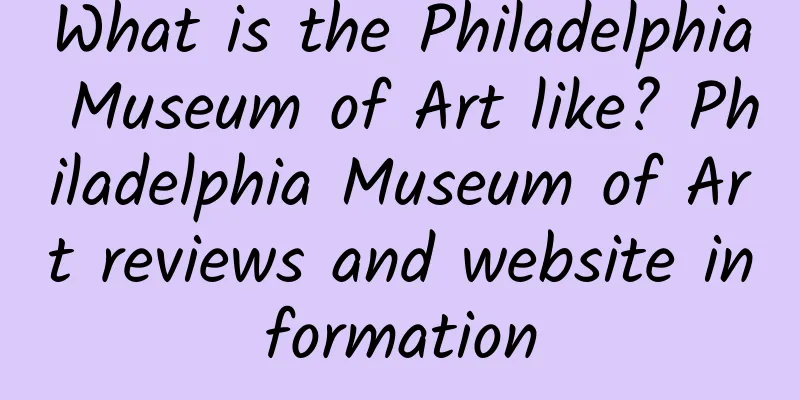Explore the Philadelphia Museum of Art: A Treasure of American Art and Culture
The Philadelphia Museum of Art, founded in 1876, is located at the intersection of 26th Street and Franklin Parkway in the northwest of downtown Philadelphia, Pennsylvania, and is the third largest art museum in the United States. The museum is famous for its ancient Greek temple-style architecture and rich art collections, attracting thousands of art lovers and tourists every year.
Architecture and History
The building of the Philadelphia Museum of Art is a work of art in itself. Its design was inspired by ancient Greek temples, and its magnificent colonnades and intricate carvings showcase the charm of classical architecture. Construction of the museum began in 1919, and it was not officially opened to the public until 1928. Since then, it has become a cultural landmark in Philadelphia and even the United States.
The museum's founding can be traced back to the Centennial Exposition of the United States in 1876. At that time, in order to celebrate the 100th anniversary of the independence of the United States, Philadelphia held a grand exposition, exhibiting art from all over the world. After the exposition, many exhibits were donated to Philadelphia and became the cornerstone of the Philadelphia Museum of Art.
Rich art collection
The Philadelphia Museum of Art is famous for its huge art collection, with more than 300,000 works of art, covering various periods and schools from ancient times to modern times. Among them, the collection of French Impressionist works is particularly outstanding, with the largest collection in the United States. The 20 exhibition rooms in the museum display a variety of art crystals, including paintings, sculptures, ceramics, textiles, furniture and decorative arts.
The museum's collection is not limited to Western art, but also includes precious cultural relics from all over the world. The collection of Chinese cultural relics is particularly eye-catching. For example, the Wanfo Pavilion caisson in the Zhihua Temple in Beijing was bought by Americans in the 1930s and is now collected in the Philadelphia Museum of Art. These cultural relics not only show the exquisite craftsmanship of ancient Chinese architecture and art, but also provide valuable information for the study of Chinese history and culture.
French Impressionist Works
French Impressionism was an artistic revolution from the late 19th century to the early 20th century, with representatives including Claude Monet, Pierre-Auguste Renoir, Edgar Degas, etc. The Philadelphia Museum of Art has a large collection of French Impressionist works, the most famous of which include Monet's "Water Lilies" series, Renoir's "The Dance" and Degas's "Ballerina".
These works, with their unique use of color and light and shadow effects, demonstrate the artists' keen observation of nature and life. The museum regularly holds exhibitions and lectures to introduce the history and artistic value of French Impressionism to the public, attracting many art lovers and scholars to come and study and research.
Chinese Cultural Relics Collection
The Philadelphia Museum of Art has a rich and diverse collection of Chinese cultural relics, covering various periods from ancient times to modern times. In addition to the Wanfo Pavilion caisson in Zhihua Temple, the museum also has a large collection of ceramics, jades, bronzes, calligraphy and paintings, and Buddhist artworks. These cultural relics not only demonstrate the superb level of ancient Chinese craftsmanship, but also reflect the profound heritage of Chinese history and culture.
The museum introduces the historical background and cultural significance of Chinese cultural relics to the public through special exhibitions and academic seminars. Through these activities, visitors can have a deeper understanding of the profoundness of Chinese culture and appreciate the artistic charm of these precious cultural relics.
Exhibitions and Events
The Philadelphia Museum of Art hosts a variety of temporary exhibitions and special events every year, covering a wide range of fields from classical art to contemporary art. These exhibitions not only showcase the museum's rich collections, but also invite artists and scholars from all over the world to communicate and collaborate.
In addition, the museum also regularly holds lectures, seminars and workshops to provide the public with opportunities to learn and interact. Through these activities, the audience can gain a deeper understanding of the history and creative process of art and participate in artistic creation and discussion.
Temporary Exhibitions
Temporary exhibitions are a major feature of the Philadelphia Museum of Art. Every year, it launches several themed exhibitions covering different art schools and periods. For example, exhibitions such as "Impressionism and Modern Art", "Ancient Chinese Art" and "Contemporary Art Newcomers" held in recent years have received widespread attention and praise.
These exhibitions not only showcase the museum’s rich collections, but also introduce many precious exhibits through cooperation with other museums and art institutions. Through these exhibitions, visitors can appreciate art masterpieces from all over the world and learn about the development of art in different cultural and historical backgrounds.
Education and Community Activities
The Philadelphia Museum of Art is committed to art education and community service, providing learning and participation opportunities for audiences of different ages and backgrounds through various projects and activities. For example, the museum's "Art Exploration" project provides elementary and middle school students with rich art courses and practical activities to help them develop their interest in art and creativity.
In addition, the museum also regularly organizes activities such as Family Day, Artist Lectures and Community Art Festivals to encourage public participation and interaction. Through these activities, the audience can have a deeper understanding of the history and creation process of art and experience the fun and inspiration brought by art.
Visiting Information
The Philadelphia Museum of Art is located at the intersection of 26th Street and Franklin Parkway in the northwest of downtown Philadelphia. It is easily accessible and there are many parking lots and public transportation stations nearby. The museum is open from 10 a.m. to 5 p.m. from Tuesday to Sunday, and extended to 8:45 p.m. on Friday. It is closed on Monday.
Tickets are $25 for adults, $20 for students and seniors, and free for children under 18. The museum also offers memberships and group ticket discounts. For more information, visit the museum's official website or consult on-site staff.
Tours and Facilities
The museum provides a variety of guided tour services, including audio guides, guided tours and self-guided maps. Visitors can choose the appropriate guided tour method according to their interests and needs to better understand the exhibits and exhibition content.
The museum has a restaurant, cafe and gift shop, providing tourists with convenient services and shopping experience. The restaurant offers a variety of food and drinks to suit tourists with different tastes and needs. The gift shop sells a variety of art books, souvenirs and handicrafts, which are a good choice for tourists to take back home.
Conclusion
The Philadelphia Museum of Art is a comprehensive museum that integrates art, history and culture. Its rich collections and diverse exhibitions provide the public with valuable art education and cultural experience opportunities. Whether you are an art lover, a historian or an ordinary tourist, you can find your own art journey here. By visiting the Philadelphia Museum of Art, you can not only appreciate the fine art from all over the world, but also gain an in-depth understanding of the development of art and historical changes in different cultural backgrounds. I hope this detailed introduction can help you better understand and plan your trip to the Philadelphia Museum of Art.










